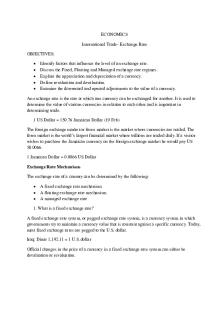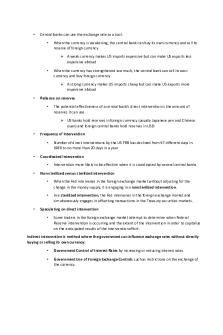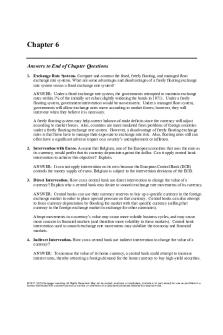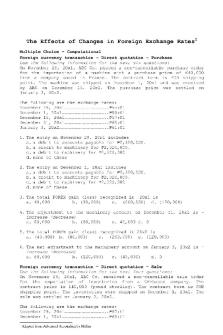Government Influence on Exchange Rates 2 PDF

| Title | Government Influence on Exchange Rates 2 |
|---|---|
| Author | Akasha Diyunuge |
| Course | Int'L Banking And Finance |
| Institution | St. John's University |
| Pages | 3 |
| File Size | 63.2 KB |
| File Type | |
| Total Downloads | 71 |
| Total Views | 158 |
Summary
LECTURE NOTES UPDATED...
Description
•
Central banks can use the exchange rate as a tool. •
When the currency is weakening, the central bank can buy its own currency and sell its reserve of foreign currency A weak currency makes US imports expensive but can make US exports less expensive abroad
•
When the currency has strengthened too much, the central bank can sell its own currency and buy foreign currency A strong currency makes US imports cheap but can make US exports more expensive abroad
•
Reliance on reserves •
The potential effectiveness of a central bank’s direct intervention is the amount of reserves it can use. US banks hold reserves in foreign currency (usually Japanese yen and Chinese yuan) and foreign central banks hold reserves in USD
•
Frequency of Intervention •
•
Coordinated Intervention •
•
•
Number of direct interventions by the US FRB has declined from 97 different days in 1989 to no more than 20 days in a year
Intervention more likely to be effective when it is coordinated by several central banks.
Non-sterilized versus sterilized intervention •
When the Fed intervenes in the foreign exchange market without adjusting for the change in the money supply, it is engaging in a nonsterilized intervention.
•
In a sterilized intervention, the Fed intervenes in the foreign exchange market and simultaneously engages in offsetting transactions in the Treasury securities markets.
Speculating on direct intervention •
Some traders in the foreign exchange market attempt to determine when Federal Reserve intervention is occurring and the extent of the intervention in order to capitalize on the anticipated results of the intervention effort.
Indirect intervention is method where the government can influence exchange rates without directly buying or selling its own currency: •
Government Control of Interest Rates by increasing or reducing interest rates.
•
Government Use of Foreign Exchange Controls such as restrictions on the exchange of the currency.
•
Intervention Warnings intended to warn speculators. The announcements could discourage additional speculation and might even encourage some speculators to unwind (liquidate) their existing positions in the currency.
•
A weak home currency can stimulate foreign demand for products. (See Exhibit 6.5)
•
A strong home currency can encourage consumers and corporations of that country to buy goods from other countries. (See Exhibit 6.6)
What is a currency devaluation? * •
Currency devaluation is a deliberate or forced downward movement of the value of a currency vis-a-vis other currency (of any other country) or currency standard.
•
Currency devaluation is generally referred to as deliberate devaluation tactics.
•
Such tactics are referred to as monetary policy and are used by the countries who have a fixed exchange or semi-fixed exchange rate.
•
The exchange rate is usually stabilized by a central bank who is responsible to buy or sell currency to maintain its exchange rate vis-à-vis other currency.
What is currency revaluation?* •
Revaluation means a change of a price of goods or products.
•
This term is specially used as revaluation of a currency, where it means a rise of currency to the relation with a foreign currency in a fixed exchange rate.
•
In floating exchange rate correct term would be appreciation.
•
The U.S. monetary authorities occasionally intervene in the foreign exchange (FX) market to counter disorderly market conditions.
•
The Treasury, in consultation with the Federal Reserve System, has responsibility for setting U.S. exchange rate policy, while the Federal Reserve Bank New York is responsible for executing FX intervention.
•
U.S. FX intervention has become less frequent in recent years.
Purpose of Foreign Exchange Intervention* The Department of the Treasury and the Federal Reserve, which are the U.S. monetary authorities, occasionally intervene in the foreign exchange (FX) market to counter disorderly market conditions. •
Since the breakdown of the Bretton Woods system in 1971, the United States has used FX intervention both to slow rapid exchange rate moves and to signal the U.S. monetary authorities' view that the exchange rate did not reflect fundamental economic conditions. U.S. FX intervention became much less frequent in the late 1990s. The United States intervened in the FX market on eight different days in 1995, but only twice from August 1995 through December 2006.
•
The Effects of Exchange Rate Changes An exchange rate is the price of one foreign currency in terms of another currency. Foreign exchange rates are of particular concern to governments because changes in FX rates affect the value of products and financial instruments. As a result, unexpected or large changes can affect the health of nations' markets and financial systems. Exchange rate changes also impact a nation’s international investment flows, as well as export and import prices. These factors, in turn, can influence inflation and economic growth.
•
The foreign currencies that are used to intervene usually come equally from Federal Reserve holdings and the Exchange Stabilization Fund of the Treasury. These holdings currently consist of euros and Japanese yen. Interventions may be coordinated with other central banks, especially with the central bank of the country whose currency is being used.
•
In recent years, the Federal Reserve and the Treasury have made their interventions more transparent. Thus, the New York Fed often deals directly with many large interbank dealers simultaneously to buy and sell currencies in the spot exchange rate market.
•
The Fed historically has not engaged in forward or other derivative transactions. The Treasury Secretary typically confirms U.S. intervention while the Fed is conducting the operation or shortly thereafter. Often, statements that reflect the official U.S. stance on its exchange rate policy accompany the Treasury's confirmation of intervention activity....
Similar Free PDFs

Exchange Rates - economics notes
- 4 Pages

Inflation, Exchange & Interest Rates
- 14 Pages

Ch07 Governmental Influence on Trade
- 21 Pages

Government notes 2
- 3 Pages

Tax Rates Handout 2 2021
- 2 Pages

American Government Chapter 2
- 5 Pages
Popular Institutions
- Tinajero National High School - Annex
- Politeknik Caltex Riau
- Yokohama City University
- SGT University
- University of Al-Qadisiyah
- Divine Word College of Vigan
- Techniek College Rotterdam
- Universidade de Santiago
- Universiti Teknologi MARA Cawangan Johor Kampus Pasir Gudang
- Poltekkes Kemenkes Yogyakarta
- Baguio City National High School
- Colegio san marcos
- preparatoria uno
- Centro de Bachillerato Tecnológico Industrial y de Servicios No. 107
- Dalian Maritime University
- Quang Trung Secondary School
- Colegio Tecnológico en Informática
- Corporación Regional de Educación Superior
- Grupo CEDVA
- Dar Al Uloom University
- Centro de Estudios Preuniversitarios de la Universidad Nacional de Ingeniería
- 上智大学
- Aakash International School, Nuna Majara
- San Felipe Neri Catholic School
- Kang Chiao International School - New Taipei City
- Misamis Occidental National High School
- Institución Educativa Escuela Normal Juan Ladrilleros
- Kolehiyo ng Pantukan
- Batanes State College
- Instituto Continental
- Sekolah Menengah Kejuruan Kesehatan Kaltara (Tarakan)
- Colegio de La Inmaculada Concepcion - Cebu









